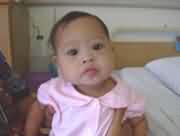What is Down Syndrome?
Down Syndrome is a genetic condition due to an extra chromosome of number 21 in the cells of the child. Three copies of the chromosome 21 (normally only 2 copies) is present in each cell. The condition is also known as Trisomy 21. The affected child is born with characteristic physical features and may have several associated medical problems. Note:
- This syndrome was named after an English doctor, Dr. Langdon Down who first described the condition in 1866.
How often does Down Syndrome occur?
The overall incidence is 1 in 800 births. The risk is higher with increasing maternal age.
How is this condition confirmed?
Confirmation is by a blood test on the child to detect the extra chromososme 21. It is also possible to diagnose the condition during pregnancy with blood tests, detailed ultrasonography or amniotic fluid analysis.
Physical features
Characteristic physical features include:
- Short stature.
- Small head size.
- Flat facial features with upward slanting eyes.
- Protruding tongue.
- Single transverse skin crease on the palms, broad hands, short fingers and a wide gap between the first and second toes.
- Delayed development.
- Mild to moderate mental disability.

A baby with Down Syndrome
Associated health problems & treatment
- Delayed development, learning disability & speech problems.
- The child is floppy at birth with delayed achievement of milestones during infancy and childhood.
- Learning disability is usually present.
- Speech development is also poor The child will benefit from early intervention programme, special education and speech therapy. Check with your doctor or health nurse about the nearest services available.
- Congenital heart disease.
- There is a higher incidence of Down syndrome children being born with a heart defect compared to normal children The doctor will screen the child for congenital heart disease and refer for cardiac evaluation as necessary. The congenital heart defect may require medical treatment and/or surgical correction.
- Abnormal gut development.
- Intestinal atresia.
- Absent anal opening These abnormalities are usually detected soon after birth and require surgical correction. These are relatively rare though incidence is higher than in normal children.
- Susceptibility to infections.
- Routine vaccination should be given. Bring the child to see a doctor early if he/she has a fever or looks unwell.
- Hearing and visual problems.
- Appropriate screening and correction of problems are required.
- Abnormal thyroid function.
- Reduced function: Hypothyroid Hormone replacement is needed.
- Increased function: Hyperthyroid Treatment consists of medication to regulate hormone production and symptoms.
- Cancer
- Acute leukemia is more common in Down Syndrome than in the general population.
- Assessment and specific treatment will be needed.
Prevention
- Genetic counseling : The recurrent risk of having another child with Down Syndrome depends on the type of chromosomal defect in the child and the age of the parents.
- General recurrence risk is 1% for most cases.
- Family planning.
Rehabilitation
- Early intervention programme.
- Occupational therapy.
- Speech therapy.
- Special education.
- Special skills training.
The aim of rehabilitation is to help the child achieve his/her maximum developmental potential and learn to be self-independent. Rehabilitation programmes are available in Community Based Rehabilitation Centres and facilities run by NGOs/voluntary organisations. Details of available local resources can be obtained from the relevant local departments: hospital (Paediatric department), health centre, social welfare branch office or education department (special education unit)
The child should be registered as early as possible with the state Social Welfare and Education Department so as to receive proper health, welfare and special education benefits. The attending doctor can assist in the registration process by filling in the relevant forms.
After registered, the child is entitled to receive benefits with regards to medical treatment from government health facilities and enrolment in schools with special education classes. Other benefits include tax relief/rebate, incentive allowance when studying or employed, trnsportation concessions, immigration fees waiver and extended pensions payment. Futher information can be obtained from the relevant departments.
Support groups
There are many support groups available worldwide and they are easily accessible through the internet.
- Kiwanis Down Syndrome Foundation
Alamat : KDSF-National Centre
Lot 13490 Jalan Jenjarum, off Jalan SS23/1,
Taman SEA 47400 Petaling Jaya
Tel: 03-78030179
Fax: 03-78064862
Website : www.kdsf.org.my
E-mail : admin@kdsf.org.my info@kdsf.org.my - Persatuan Sindrom Down Malaysia
Alamat : 79 Lingkungan U-Thant,
55000 Kuala Lumpur
Tel : 03-42579818
Website : http://www.mysindromdown.org
E-mail : psdm@tm.net.my - Langdon Down Centre
2a Langdon Park Teddington TW11 9PS
Tel : 0845 230 0372
Fax : 0845 230 0373
Website : http://www.downs-syndrome.org.uk
Email : info@downs-syndrome.org.uk
| Last reviewed | : | 25 April 2012 |
| Content Writer | : | Dato’ Dr. Jimmy Lee Kok Foo |
| : | Dr. Leow Poy Lee | |
| Reviewer | : | Dr. Ranjini S. Sivanesom |







